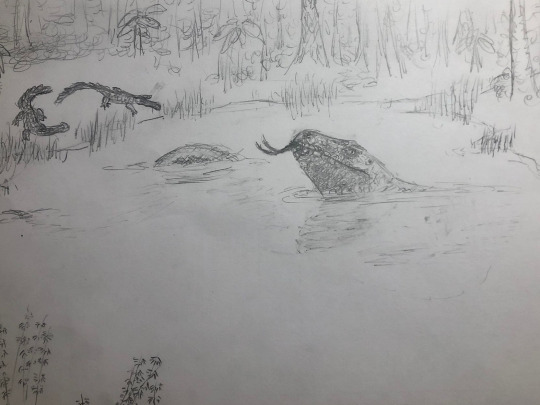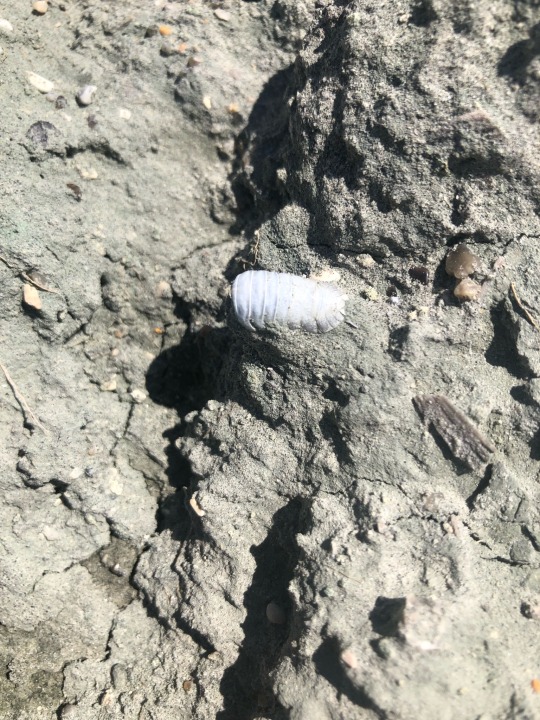#palaeostuff
Text

NEW PAPER FROM CAU HUGE IF TRUE
Cau A. (2024). A Unified Framework for Predatory Dinosaur Macroevolution. Bulletin of the Italian Paleontological Society , 63(1): 1-19. doi:10.4435/BSPI.2024.08
188 notes
·
View notes
Text
FEBUZOIC DAY 1
Canada - Danian stage, 66Ma before present

Last year, the world ended.
A female troodontid wanders through a burned-out forest, scrounging through the ash for any scrap of food to eat, occasionally stopping and calling out to something that is not there. Her feathers are unkempt and her movements are pained; she is not well. This time last year, the spring had yielded a plethora of fruits and flowers for her to feast on, along with the small birds and mammals that completed her diet. Then there was a huge flash, and a thunderous wave of sound that knocked her off her feet, and the world had been changed forever.
The summer was cold and barren, broken only by forest fires. The autumn was no different, and the winter was worse. This spring has brought no relief, grey and ashen rather than green and bountiful. Troodontids band together in times of high stress, but she has not seen another of her her kind in 6 months, only secretive little mammals living on roots and hibernating insects and scrawny birds searching for seeds, both too elusive for her to tackle in her weakened state. Dormancy is the key to survival in this post-apocalypse, either waiting it out or depending on others who are. She can do neither.
She calls out to the dead forest again, hoping that others of her kind are out there. Her cries are met only with the noise of the cold, ash-heavy wind.
By the next morning, the forest has gone silent
#palaeostuff#anthem posts#anthems art#troodon#palaeontology#palaeoblr#palaeoart#this is for draw a dinosaur day as well#febuzoic 2024
99 notes
·
View notes
Text
FEBUZOIC DAY 4
Queensland, Australia - Ypresian stage, 55Ma before present

300,000 years ago, the planet experienced a short, geologically speaking, spike in temperatures that caused somewhere between 5-8C of warming. This spike marked the transition from the Palaeocene epoch to the Eocene, and although the event is over, the already hot world of the Cenozoic is slowly getting hotter. Dawn breaks on a greenhouse planet.
As the light touches the shores of lake Murgon, the last of the bats retreat into the shadows, and the crocodiles, giant snakes and odd wading birds that line the shore are revealed. The plethora of water-loving insects begins to hum in the suns rays, but their noise in punctured by a new sound; birdsong. A small, relatively unassuming looking bird hops along the rocks of the shoreline, stopping occasionally to produce short bursts of complex vocalisation. He is a one of the first passerines, a group that in the modern day contains around half of all bird species, from crows to blackbirds to the New Zealand rock wren.
Birds, the only dinosaurs to have survived the extinction event 11 million years ago, have exploded in diversity and are now fulfilling a huge number of roles in the ecosystem. There are now a huge amount of birds calling to eachother in the dawn, and the songs of this little bird pick it out from the crowd of not just other bird species, but other birds of the same species. As time passes, the evolutionary process will select for more and more intricate songs until they arrive in the Holocene in their beautiful modern form.
#Eocene#palaeostuff#anthem posts#anthems art#palaeontology#paleoart#palaeoart#palaeoblr#passeriformes#FYI the fossil this part is based off is fragmentary and it is currently in question as to whether it is actually even a passeriforme at al#but ultimately its a bird its a miracle if any of them fossilise the first passerine could be living in hordes at Murgon and we'd never kno#Febuzoic 2024
60 notes
·
View notes
Text
Not seen anyone post about Ichthyotitan yet. A 25m long, if the estimates are right, this thing outclasses fucking Shastasaurus!!! That’s crazy!!!! It is only known from the jaw at the moment though, so we’ll have to see what future finds reveal.

Image credit to Gabriel Ugueto
41 notes
·
View notes
Text
FEBUZOIC DAY 3
Morocco - Thanetian stage, 57Ma before present

As the Palaeocene epoch continues, temperatures remain high, and life continues to evolve in the hothouse. The jungles of Jbel Guersif are too thick for giant reptilian predators, and the lush foliage provides food and shelter to the many warm blooded decendents of the survivors of the asteroid impact. Small birds flit through the canopy, and mammalian predators stalk through the branches.
One mammal in particular is moving through the canopy with relative ease and speed: this is Altialtasius, one of the very first primates. To aid her as she climbs and leaps and clambers, her claws have flatterned into fingernails, exposing the pad of her fingers for grip; her eyes are forward facing to help her judge the distance between branches, and she can see in three colours, to help pick out fruit for her to eat. Mammals lost 2 of their 4 cone types during the mesozoic, as they didn't need them for their nocturnal lifestyle. Primates, however, have re-evolved their red cones as the ability to distinguish purples, reds, oranges and yellows from blues, greys and greens is a massive aid in finding fruit in amongst the sea of rainforest leaves.
#palaeostuff#anthem posts#anthems art#febuzoic 2024#palaeoblr#palaeontology#primates#Altialtasius#palaeocene
8 notes
·
View notes
Text
FEBUZOIC DAY 2
Colombia - Selandian Stage, 60Ma before present

It has been 6 million years since the asteroid impact that brought the Mesozoic era to an end, and the world has recovered. Lush green forests cover the wet of the Earth once more, no longer strangled by clouds of ash, and the seasons pass by in their normal state. It has, however, been getting considerably hotter during this time, and this has shaped the emerging world of the Cenozoic. A new biome has come to dominate the inflated tropical regions of the equator; tropical broadleaf rainforest, an ecosystem type synonymous with this climate today.
It is not just the flora that has been shaped by this heating world, but the fauna. Cold-blooded reptiles have done exceptionally well post-extinction, with their slowed metabolisms, which had increased their chance of survival during the cold, harsh decades after the impact, now speeding up in the heat, allowing them to dominate the megafaunal roles of the Palaeocene world.
Winding his way through the waters of the Cerrajon wetlands is one of the largest Palaeocene reptiles: Titanoboa. Although this giant snake is mainly piscivorous, other local animals give him a wide berth as his size and the potential crushing power of his coils prove no match for other predator in his environment.
#titanoboa#palaeontology#palaeostuff#anthem posts#anthems art#palaeoblr#palaeocene#paleontology#febuzoic 2024
7 notes
·
View notes
Note
Ngl I'm mildly obsessed w/ you at first glance. I love paleontology but have kind of fallen off the train in my knowledge over the years and I love queer people being into it as well.
Anyways, do you have any interesting perspective or rambles on newer theories regarding dromeosaurid pack hunting? From what I understand there's been a general scientific consensus that it was less coordinated than previously depicted, and that it was more groups mutually hunting in opportunistic ways as opposed to coordinated behaviors that we see in modern wolves and such.
Year, that is the consensus. It arose from an isotopic study on Deinonychus showing that the young were eating different food to the adults, so the adults were not feeding the young. The theory put forward from here was that dromaeosaurids were not living in family groups, like wolves do, but that adults would form loose 'mobs' to take down larger prey, like Komodo dragons do. My personal stance on this is that it might not be as clear cut as the theories would make out, and the way that dromaeosaurids hunted together may have no modern analogue at all.
Also please stay mildly obsessed with me. I'm very sexy and silly and queer and more of an attention whore than i'd like to admit :3 Thank you. grins
23 notes
·
View notes
Note
Trick or treat! :)
Treat!! Fossil Isopod :)

6 notes
·
View notes
Text

New research from Cullen et al!!!!! what do we think?
31 notes
·
View notes
Text
What do you MEAN Texas doesn’t have a state fossil??? The Texas Redbeds are one of THE defining terrestrial fauna sets of the Permian. DIMETRODON IS RIGHT THERE!!!!
#also like 5 states have Mammoths as their state fossil and a further 2 have Mastodons#cmon guys someone has to change#Nebraska has the Agate springs fossil beds you can pick something from that can’t you?#palaeostuff
7 notes
·
View notes
Text
I've been thinking about the thin line between extinct and non-extinct taxa.
Wonambi naracoortensis was a big snake, sure, but it wasn't even as large some as modern Anaconda specimens.
We see extinct taxa like the madtsoiids with a certain glamour or sheen that separates them from pythonids or boids. They aren't seen as 'normal animals', when they would just be another family of constrictor snakes had Wonambi survived another couple thousand years, another deadly snake in the Australian outback, another ancient monogeneric family like the platypus.
It's easy to forget that extinct animals were normal animals too sometimes, when we can only see them far in the rear-view mirror, obscured by the ages of wind and rain and dust and stone. But it's always important remember.
We miss you Wonambi.
2 notes
·
View notes
Text
OK sauropodomorph poll slightly obscure
5 notes
·
View notes
Text
David Attenborough voice The Velossy Raptor
19 notes
·
View notes
Note
favorite ancient creature?
It's a hot competition, but I think Devincenzia is my favourite.
Of the terror birds, the phorusrhacines were the largest, all of them being 2.5m-3m tall. Devincenzia pozzi is the last phorusrhacine we find in South America (Titanis appears later, but is restricted to Southeast USA). I love all the terror birds but I love Devincenzia the most.
Other runners up include Basilosaurus (which I have a whole sideblog for, @basilosaurus-fanblog), Daeodon, Sauroposiedon, Dreadnoughtus, Neovenator, and. so many others that I can't name right now. I got an ask about it ages ago look at my 'askes' tag.
8 notes
·
View notes
Text

32 Locations. What does it mean?
9 notes
·
View notes
Note
Ask you about paleontology you say. Do you know why the mimetaster is called that? I can’t figure out any possible explanation for why it is called that.
The name Mimaster means ‘Mimic Star’ or ‘Asterias Mimic’ as far as I can see. The original 1931 paper makes reference to Asterias, a genus of starfish including the North Atlantic Common Starfish, and a great many starfish and superficially starfish-like genera use -aster as a suffix.
However, Mimaster was occupied by a (now defunct) genus of actual starfish, so it was changed to Mimetaster; the alteration of the name does not effectively alter its meaning in this case :)
5 notes
·
View notes